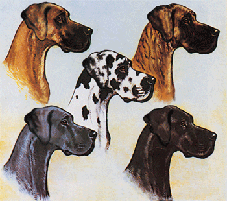great dane portrait
history:
Before many thousands of years big and strong dogs had been breeded. This
dogs not only had to defend their master, herds and farm. They had to prove
in fight against bears, wolfs and wild boars.
Near all nations, Assyrian, Persian, Greek, Roman, Celt and German gave us
potrayals of big dogs.
In early roman age molosses had kept as powerful battle dogs.
In Germany in the Middle Ages the powerful dogs near exclusive kept
by nobility in big packs. They called "Bärenfänger",
"Saupacker", "Hatzrüden" aund "Bullenbeißer"
what infer to purpose use of them at that time.
Until end of the 18th century for example in Dessau country (Germany) every year
between 800 and 2000 boars were hunted with help of danes. In the Year 1820 in whole
country not 100 boars were found. (found in an old book about dogs races in
Germany in the 19th century).
In many sections of Germany boar hunting had ended at the beginning of the
19th century. The "Bullenbeißer" were only knowing by their
name and the english danes from the nobility hunting houses and kennels
changed to privat owners.
The german "Bullenbeißer" total disappeared.
But the english danes were breeded numerous as luxury dogs, most in
country Württemberg in Ulm and invirons.
The name "Dogge" comesfrom the english word dog. The english breeder
had refined the thousands of years old protection dogs and created breeds today
we knowing as "Doggen".
In Germany this breeds had different names. There were the
"Ulmer Dogge", because people in Württemberg rendered a great
kontribution in holding of the strong dogs.
In other sections of Germany they called "Dänische Dogge"
(great dane), this name is actual until today in France ("Grand Danois")
and all english speeking countrys ("Great Dane"). Why this name was
created is unknown. The Danes didn't do much in breeding and refining in these
race.
In front of breeding these race with many success, in 1878 in Berlin a committee
of 7 people, consists in engaged breeders and breeing judgemen with chairmanship
of Dr. Bodinus took the resolution that all name variants are unite in the
name "Deutsche Dogge". This was the foundation of an own german dog race.
In 1880 in opportunity of a dog show in Berlin first time the standardisation for
the race Deutsche Dogge was commited. At 12th of January in 1888 the
"Deutsche Doggen-Club" (DDC) was founded in Berlin. Since foundation
of the DDC this club is risponsible for the race standard, which is repeated
changed. The race standard corresponds to handicaps of Fédération Cynologique
Internationale (F.C.I.).
In 1897 the first breeding book was published by the DDC. Until today the
Deutsche Doggen-Club 1888 e.V. (DDC) is leading the breeding book for all
danes breeding under his name and is risponsible for the race standard.
appearance:
The Deutsche Dogge completes in his totality big, strong and pleasing build
pride, strength and elegance. Her substance in addition with nobility,
harmony of his outward appearance, a well proportioned line leading and the
very expressive head for the observer she seems to be a nobility statue.
She's the "Apoll" under all dog races.
The body is near square. Males high is 80 cm at least, females high is 72 cm at least.
Danes are friendly, lovely and clinging to their owner, special to children.
Against foreigners she'll be little bit reserved. She's a self-confident, unfrighten,
easy leading and quick to learning family and companion dog with high stimulus
threshold without aggressive behaviour.
The ears are since 1987 hanging, middle big and laying in attention with the front
border on the cheek. The dane has a short, solid, thick and shining fur.
Fur cleaning therefore is simple.
Danes are breeding in 5 colours and 3 variations.
The 3 variations:
The five colours:

|
|
fawn:
|
light golden yellow until rich golden yellow, always with a black mask.
Undesirable are white marks at breast and toes.
|
|
gestromt:
|
Grundfarbe Hellgoldgelb bis zum satten Goldgelb mit
main colour light golden yellow until rich golden yellow
possible with equal clear stripes in direction of the ribes,
always with a black mask.
Undesirable are white marks at breast and toes.
|
|
harlequin:
|
(so called tiger danes) main colour total white,
possible without sneering remarks with uneven well
spread black spots.
Undesirable are grey or brown spots.
|
|
black:
|
vanish black, white marks are allowed.
In addition to this are the coat tiger. The dogs has a
coated black and mouth, neck, stomach, paws and tail end
can be white; also danes with white main colour and big
black plates (plate dogs).
Black danes are comeing out of the colour variants
harlequin / black and blue / black (blue breeding).
|
|
blue:
|
Rein stahlblau. Weiße Abzeichen an Brust und
Pfoten sind zugelassen.
|
|
|
family suitability:
The dane is good-natured and loving, wants to be always with
near his family. Against known person she'll be clinging.
Against foreign persons she'll be little bit reserved.
Seldom there are problem with other dogs. But her physical
strength has to be well directed.
The actual standard of Danes is registered under
F.C.I.-Standard Nr. 235/10.04.2002/D
Ursprung: Deutschland
Verwendung: Begleit-, Wach- und Schutzhund.
F. C. I. - Klassifikation:
Group 2: Pinscher and Schnauzer, Molossoide, Schweizer Sennenhunde and other races
Section 2.I: Molossoide, doggenartige Hunde ohne Arbeitsprüfung
